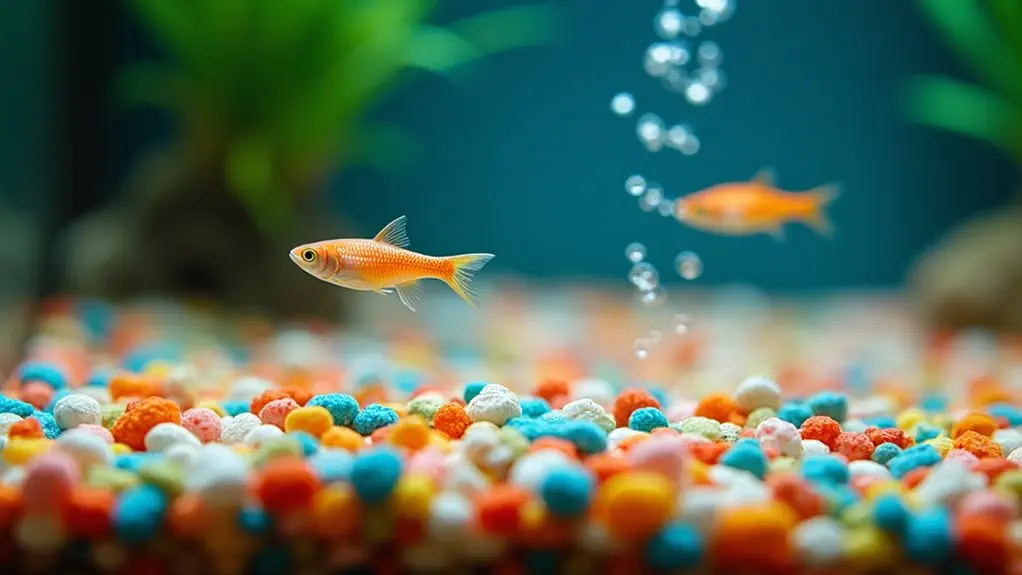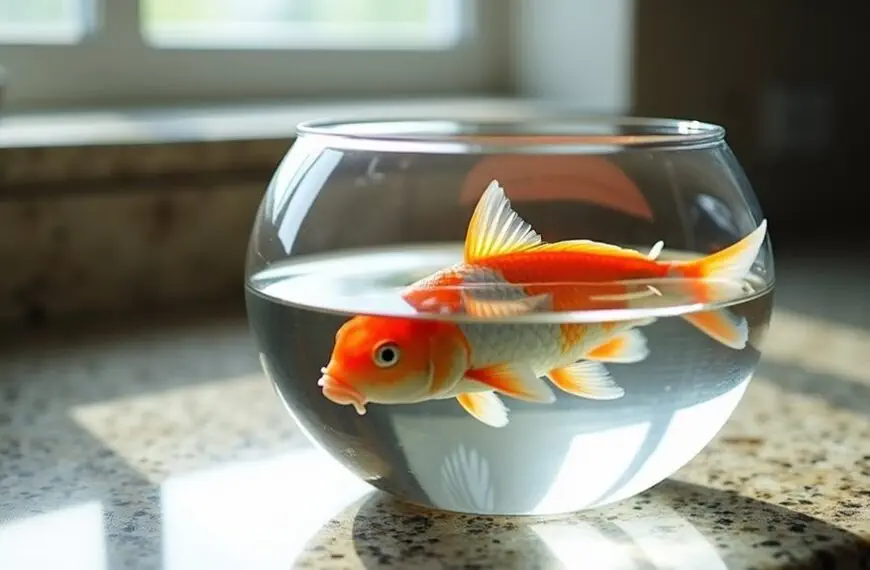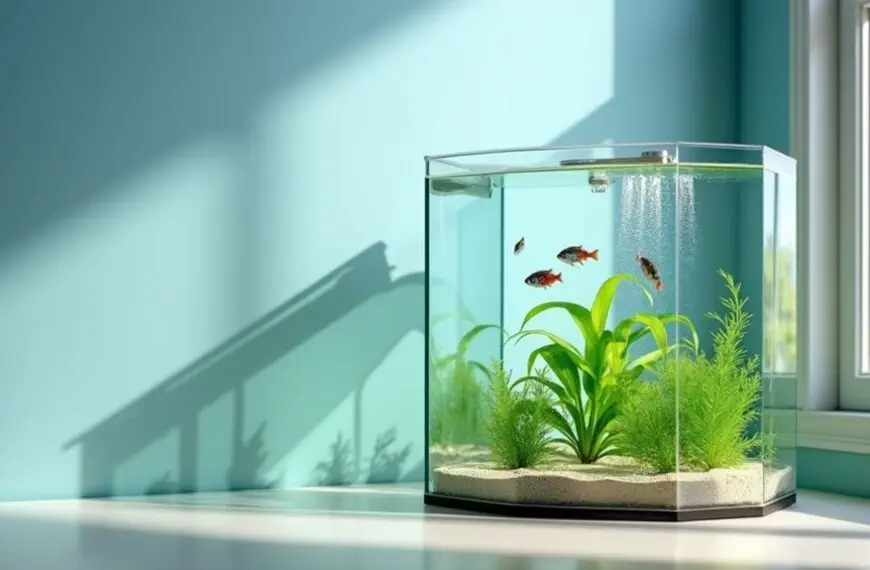Gravel isn't just there to make your fish tank look pretty – it's actually an essential part of your aquarium's ecosystem. You'll find that gravel creates a natural home for beneficial bacteria, which break down harmful waste and keep your water chemistry balanced. It provides vital hiding spots for your fish, reducing their stress levels and making them feel secure in their environment. Plus, if you're into aquatic plants, gravel gives their roots something to grip onto while helping maintain proper water flow. When properly maintained with regular cleaning, your gravel bed becomes the foundation for a thriving underwater world that'll keep your finned friends swimming happily. There's so much more to discover about how this simple substrate keeps your aquarium healthy and vibrant.
Contents
- 1 The Essential Role of Gravel
- 2 Natural Habitat Creation
- 3 Beneficial Bacteria Growth
- 4 Plant Life Support System
- 5 Water Chemistry Balance
- 6 Fish Stress Reduction
- 7 Tank Maintenance Best Practices
- 8 Choosing the Right Gravel
- 9 Aesthetic Design Elements
- 10 Proper Gravel Depth Requirements
- 11 Frequently Asked Questions
- 11.1 Can I Mix Different Types and Colors of Gravel in One Tank?
- 11.2 How Often Should I Completely Replace All the Gravel in My Tank?
- 11.3 Will Gravel Affect My Tank's Water Temperature?
- 11.4 Can Gravel Damage My Filter System if Accidentally Suctioned Up?
- 11.5 Does the Weight of Gravel Impact Tank Placement on Furniture?
- 12 Final Thoughts
The Essential Role of Gravel
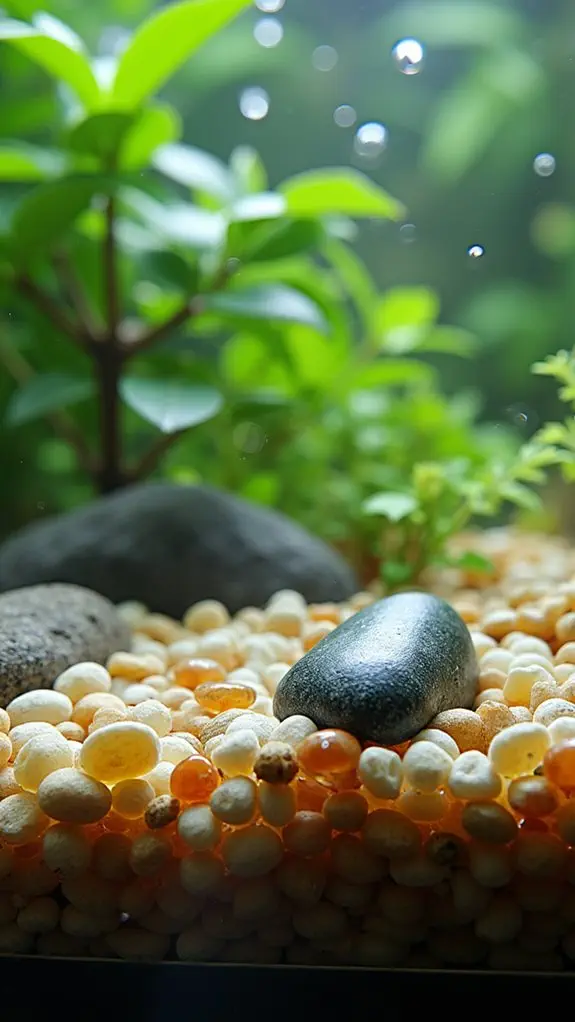
Within the confines of an aquarium, gravel serves as more than just a decorative element. When you're choosing between different gravel types, you're actually selecting a vital component that'll determine your tank's overall health and stability. This humble substrate benefits your aquatic ecosystem in ways you mightn't even realize.
Think of gravel as your tank's hardworking maintenance crew. It's constantly providing a cozy home for beneficial bacteria that break down harmful waste products like ammonia and nitrite. These microscopic helpers colonize the surface of each tiny pebble, turning your gravel bed into a powerful biological filtration system. Your fish will feel more secure and less stressed as the substrate provides natural hiding spots for them to retreat to when needed. The ideal thickness of 1-2 inches of gravel ensures optimal filtration performance.
You'll notice clearer water too, as the gravel traps floating debris before it can cloud your view.
But that's not all – your gravel's also working double-duty as a mechanical filter. It helps distribute water flow evenly throughout your tank, preventing those pesky stagnant areas where problems can develop.
If you've got aquatic plants, they'll thank you for the stable foundation, as gravel gives their roots something sturdy to grab onto while helping deliver essential nutrients.
Natural Habitat Creation
Creating a natural habitat in your aquarium starts with choosing the right gravel to mimic your fish's wild environment. Through thoughtful substrate selection, you'll provide your aquatic friends with essential spaces for burrowing, foraging, and even hiding from that pesky tank mate who won't leave them alone.
When you're planning your tank's habitat diversity, consider how gravel affects both function and beauty. You'll find that different types of gravel can work together to create stunning aquascapes while supporting your fish's natural behaviors. Enriched substrates can significantly enhance the growth and vitality of your aquarium ecosystem. The gravel acts as a home for beneficial bacteria that help maintain water quality through biological filtration and contributes to the tank's aesthetics through diverse colors and textures.
For bottom-dwelling species, you're giving them a perfect playground to sift through for tasty bits of food, while egg-laying fish will thank you for providing safe spaces for their future families.
Don't forget about your plants! If you're planning to add some greenery, your gravel choice becomes even more vital. It'll serve as an anchor for roots and a storage system for nutrients.
Plus, the right gravel can help maintain stable water chemistry, acting like a natural buffering system. Whether you're going for a peaceful river bottom look or a vibrant coral reef theme, your gravel selection will set the foundation for a thriving underwater community.
Beneficial Bacteria Growth

You'll find that gravel isn't just a pretty addition to your fish tank – it's actually a bustling city for beneficial bacteria that keep your aquarium healthy. These microscopic helpers need plenty of surface area to thrive, and that's exactly what gravel provides as they work hard to convert harmful ammonia into safer compounds. As these bacteria colonize the gravel, they play a crucial role in establishing beneficial nitrifying bacteria, which is essential for maintaining a balanced ecosystem in your tank. When you're setting up your tank, remember that these beneficial bacteria are your aquarium's cleaning crew, breaking down waste and maintaining water quality through the nitrogen cycle. Experts recommend using at least one inch of gravel to ensure optimal bacterial colonization. Small gravel between 3-6 millimeters works best for supporting bacterial growth while preventing excess food accumulation.
Bacterial Colony Establishment
The successful establishment of beneficial bacteria in your aquarium depends heavily on the gravel or substrate you choose. Your bacterial diversity will thrive when you provide at least an inch of gravel, though deeper beds of three inches or more can support even larger colonies. These beneficial bacteria typically reside in the top few inches of the substrate.
When you're making your substrate selection, remember that these tiny beneficial organisms will make your gravel their home sweet home. Regular gravel vacuuming helps maintain optimal conditions for bacterial growth without disrupting their colonies. Additionally, maintaining proper water quality parameters is essential for the health of these bacteria and the overall aquarium ecosystem.
You'll find that most of your tank's biological filtration actually happens right in the gravel bed, where bacteria convert harmful ammonia into less toxic substances. While your filter does house some beneficial bacteria, it's the substrate that's doing the heavy lifting.
Think of your gravel as a bustling bacterial city, with millions of microscopic residents working 24/7 to keep your fish healthy.
When it's time for maintenance, you'll want to be gentle with your bacterial friends. While gravel vacuuming is necessary, don't go overboard – these bacteria are your tank's cleanup crew!
If you need to change the substrate, do it gradually by replacing only half at a time to keep your bacterial colonies strong and stable.
Surface Area For Growth
Building on the bacterial colonies' success, surface area serves as the foundation for beneficial bacteria growth in your aquarium.
You'll want to guarantee your gravel layer is at least an inch deep, as this provides the perfect home for these microscopic helpers. The more surface area you provide, the greater bacterial diversity you'll achieve in your tank, leading to a healthier ecosystem. Regular testing of water parameters can help ensure these bacteria thrive optimally.
The substrate texture plays an essential role in how effectively bacteria can colonize. While standard gravel works well, you've got even better options like bio-media and ceramic rings that offer more surface area for your bacterial friends to set up shop. Proper filtration helps maintain these bacterial colonies at optimal levels.
Think of it as giving them a bigger neighborhood to live in! When you're setting up your tank, remember that these bacteria aren't just hanging out – they're your clean-up crew, breaking down waste and keeping your water quality in check.
If you're planning to add plants to your aquarium, you'll want to increase your substrate depth to about 3 inches. This extra space not only supports root growth but also creates more real estate for beneficial bacteria to thrive. Maintaining nitrate levels below 20 ppm is also essential for their effective functioning.
Nitrogen Cycle Support
Maintaining a healthy nitrogen cycle starts with understanding how your gravel supports beneficial bacteria growth.
You'll find that your gravel bed acts as a bustling city for microscopic helpers that process various nitrogen sources in your tank. These beneficial bacteria are the unsung heroes that convert harmful waste products into less toxic substances.
When fish waste and uneaten food settle into your gravel, they break down and release ammonia. That's where your bacterial cleaning crew gets to work! The bacteria in your gravel perform ammonia conversion, transforming these toxic compounds into safer nitrites and eventually nitrates. Deep gravel beds of 4 to 10 centimeters are particularly effective at fostering these bacterial colonies. Stable ecosystems help maintain the balance of these beneficial bacteria, ensuring their effectiveness.
You'll want to keep your gravel at least an inch deep to provide enough space for these helpful microorganisms to thrive.
Don't go overboard with gravel cleaning, though – a gentle vacuum that removes debris while leaving some of the beneficial bacteria intact is your best bet.
Think of it like maintaining a garden: you want to pull the weeds without disturbing the healthy roots. Regular water changes and careful monitoring will help you maintain this delicate balance in your aquatic ecosystem.
Plant Life Support System
Gravel serves as a critical foundation for your aquarium's plant life support system, performing multiple essential functions beyond simple decoration.
When you're setting up your tank for plant growth, you'll find that different substrate types can greatly impact your success. While gravel doesn't provide nutrients on its own, it creates an ideal environment for root development and anchoring.
You'll want to verify you're using the right depth of gravel – at least 3 inches for most aquatic plants. Think of it as creating a cozy underground apartment complex for your plant roots!
While they're settling in, you can supplement their nutrition with root tabs or liquid fertilizers, since gravel isn't naturally nutrient-rich. The spaces between gravel pieces allow water to flow freely, delivering essential oxygen to your plants' roots. Additionally, maintaining good water quality is crucial for the overall health of your plant life.
Water Chemistry Balance
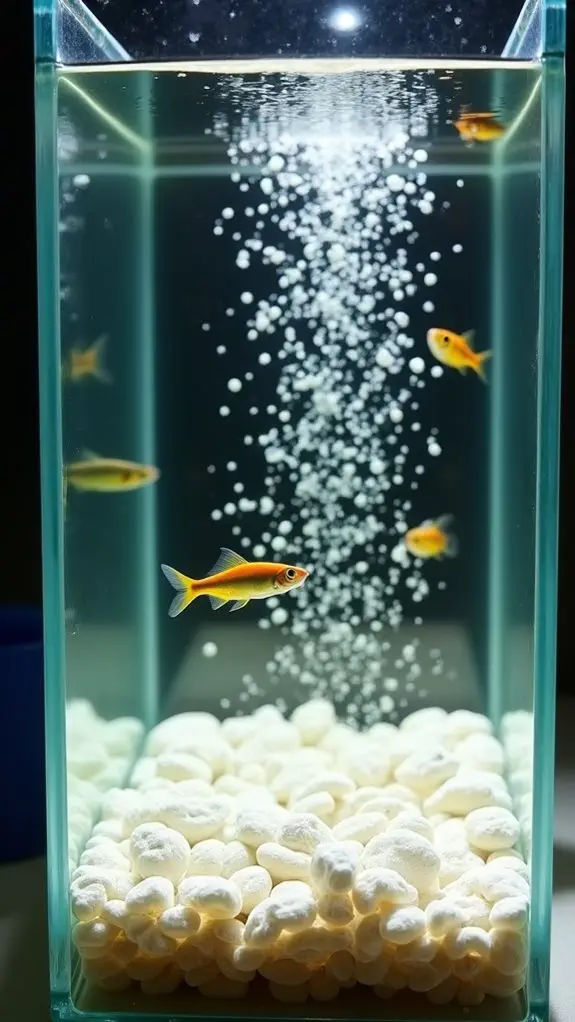
A delicate dance occurs between your aquarium's gravel and its water chemistry. Your choice of substrate types plays a vital role in maintaining stable water parameters, and it's fascinating how something as simple as gravel can have such a powerful impact on your underwater world.
When you select substrates like crushed coral or aragonite, you're actually giving your aquarium a natural buffering system. These materials help maintain consistent pH levels and contribute to proper water hardness, which your fish will definitely thank you for! Think of it as nature's chemistry lab working right in your tank.
The best part? Your gravel isn't just sitting there looking pretty – it's actively participating in your tank's health. As water flows through the substrate, it's constantly working to balance mineral content and alkalinity. Moreover, maintaining the right pH levels is crucial for preventing stress and supporting fish vitality, ensuring a thriving ecosystem.
If you've got dark-colored natural gravel, you're also helping your fish feel more secure and showing off their beautiful colors. Just remember to choose gravel with grain sizes between 3-6 mm – it's like picking the perfect-sized bed for your beneficial bacteria to thrive in while preventing those pesky food particles from getting trapped.
Fish Stress Reduction
Beyond its role in water chemistry, your tank's substrate serves as a powerful stress-reduction tool for your aquatic friends.
You'll notice positive fish behavior when you've got the right gravel setup, as it creates a more natural environment that helps your fish feel at home. Just like you'd feel stressed living in an empty room with mirrors everywhere, fish get anxious when they're surrounded by reflective surfaces.
When you add gravel to your tank, you're actually creating a therapeutic environment that benefits both you and your fish. The substrate not only supports aquatic plants but also helps promote beneficial bacteria growth, which is crucial for a balanced ecosystem.
Those stress indicators you might see in fish, like darting movements or hiding, often decrease when they've a proper substrate. The gravel doesn't just help your fish – it'll make your viewing experience more relaxing too.
You might find yourself unwinding as you watch your fish naturally explore and forage through the gravel, accompanied by the soothing bubble sounds of your aquarium.
Tank Maintenance Best Practices
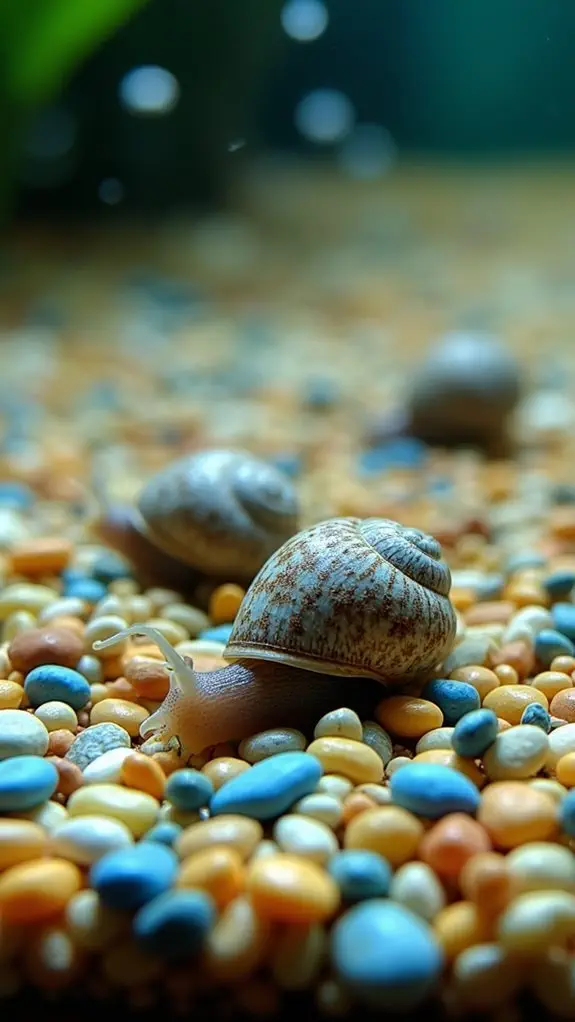
Maintaining your aquarium according to a regular schedule keeps your fish healthy and your tank looking pristine.
Whether you've got gravel, sand, or another substrate type, proper tank cleaning is essential for a thriving underwater environment. You'll want to develop a daily routine of checking water temperatures, removing excess food, and monitoring your fish's behavior.
Weekly maintenance is where you'll really roll up your sleeves. Plan to change 10-15% of the water and give those glass walls a good scrub to keep algae at bay. Additionally, keeping an eye on your water quality parameters will help you identify any potential issues before they affect your fish.
Don't forget to vacuum your substrate – it's amazing how much debris can hide between those tiny pieces of gravel! When you're cleaning, you'll want to be gentle but thorough, especially during deep cleaning sessions when you're handling decorations and pruning plants.
Choosing the Right Gravel
Selecting the right gravel for your aquarium sets the foundation for a healthy underwater ecosystem. When you're exploring different gravel types, you'll find options ranging from natural pea gravel to vibrant colored varieties that can transform your tank into an underwater masterpiece.
It's important to take into account both functionality and aesthetics, as your choice will impact not only how your tank looks but also how well it supports your aquatic friends.
- Choose gravel colors that complement your fish and create a stress-free environment.
- Reflect on particle size based on your fish species and filtration needs.
- Select materials that maintain proper water chemistry for your specific setup.
You'll want to think about your tank's inhabitants when making your selection. If you're keeping bottom-dwellers, you might prefer smaller gravel or sand to prevent injury to their sensitive bellies.
For planted tanks, specialized plant-specific gravel provides essential nutrients for healthy growth. Don't forget about depth – you'll need at least 2 inches of gravel to support beneficial bacteria and proper filtration. Additionally, proper tank size ensures that your gravel choice enhances the overall balance and stability of your aquatic environment.
Aesthetic Design Elements
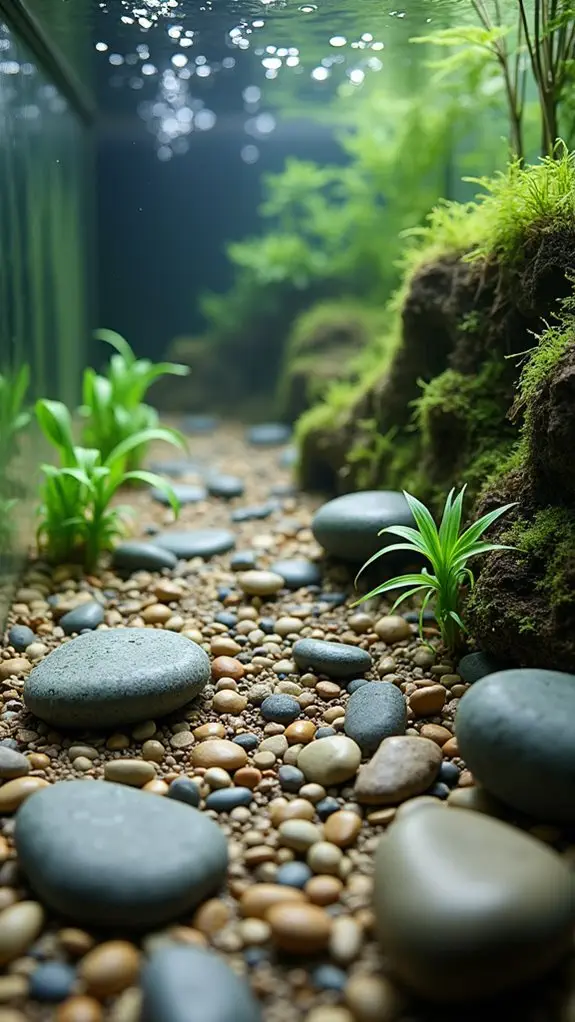
A well-designed aquarium transforms into a living work of art through thoughtful gravel placement and arrangement. When you're considering gravel aesthetics, you'll find that different colors and textures can create stunning underwater landscapes that'll captivate anyone who sees your tank.
You can use the rule of thirds to achieve a natural, balanced look that draws the eye exactly where you want it to go.
Your decorative arrangements don't have to be complicated to be beautiful. Try creating gravel pathways that weave through your tank, or layer different types of gravel to simulate a beach-like environment.
You'll want to avoid perfectly symmetrical designs – nature isn't a mirror image, after all! Instead, focus on creating visual flow by using gravel to guide the viewer's eye through your aquatic masterpiece.
Consider incorporating driftwood or rocks, anchoring them securely in the gravel for a more dynamic display. The best part? You can always change things up when you're ready for a fresh look.
Whether you're going for a serene underwater garden or a dramatic rocky landscape, your gravel choices will set the stage for your aquatic design.
Proper Gravel Depth Requirements
Beyond the visual appeal of your aquarium's layout, proper gravel depth serves as the foundation for a healthy underwater ecosystem. When it comes to substrate layering, you'll need to take into account both your tank's size and its inhabitants' needs. For most standard aquariums, maintaining a gravel depth of 1.5 to 2 inches will create an ideal environment for beneficial bacteria and proper filtration.
Here's what you'll want to keep in mind for different gravel types and setups:
- For planted tanks, aim for at least 3 inches of substrate to support healthy root growth.
- If you're using sand, stick to 1-1.5 inches to prevent harmful anaerobic pockets.
- Large tanks (55+ gallons) benefit from depths over 2 inches for a more stable ecosystem.
You can easily calculate how much gravel you'll need by using the simple formula: length x width / 10, then divide by 2.2 for kilograms.
Frequently Asked Questions
Can I Mix Different Types and Colors of Gravel in One Tank?
While you can mix gravel colors, be cautious with different types. Color combinations can create unique aesthetics, but varying grain sizes cause compaction issues. For best results, stick to similar-sized gravel with complementary colors.
How Often Should I Completely Replace All the Gravel in My Tank?
You shouldn't completely replace all gravel at once. Instead, focus on regular gravel maintenance through vacuuming and partial replacements of 25-30% every 6-12 months to maintain your tank health and beneficial bacteria.
Will Gravel Affect My Tank's Water Temperature?
No, your gravel won't directly affect water temperature. While it provides minimal insulation, gravel's main impact on temperature comes from how it affects water circulation patterns throughout your tank, which can influence heat distribution.
Can Gravel Damage My Filter System if Accidentally Suctioned Up?
Yes, if your filter sucks up gravel, it can damage the pump and impeller. That's why it's important to choose appropriate gravel types and perform careful filter maintenance to prevent accidental suction.
Does the Weight of Gravel Impact Tank Placement on Furniture?
Yes, you'll need to take into account gravel weight when placing your tank. The added weight can greatly impact tank stability on furniture, so you should always check furniture's weight capacity before setup.
Final Thoughts
You'll find that gravel isn't just a pretty addition to your aquarium – it's an essential component that makes your fish tank thrive. From hosting beneficial bacteria to anchoring plants and maintaining water chemistry, gravel creates a complete ecosystem for your aquatic friends. Whether you're a beginner or seasoned aquarist, choosing the right gravel and maintaining proper depth will help you create a healthy, beautiful underwater home that your fish will love.

